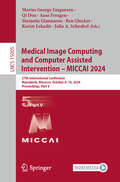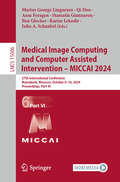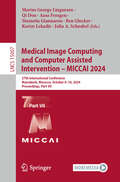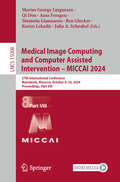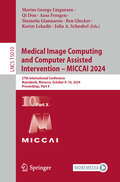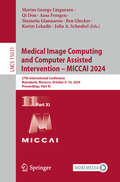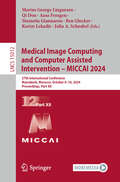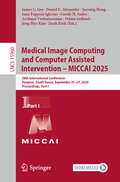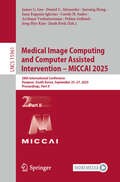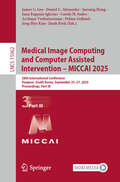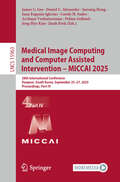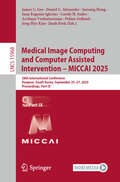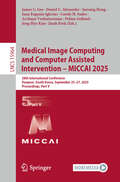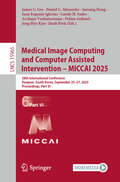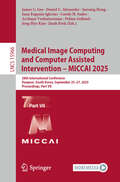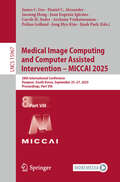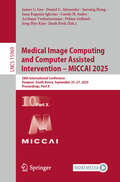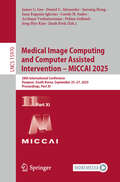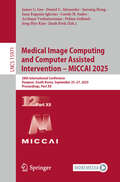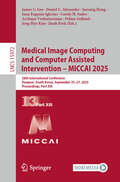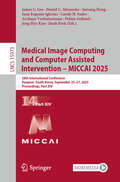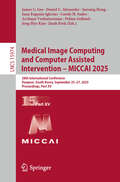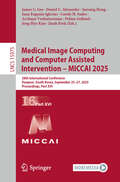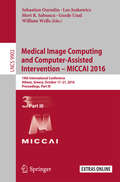- Table View
- List View
Medical Image Computing and Computer Assisted Intervention – MICCAI 2024: 27th International Conference, Marrakesh, Morocco, October 6–10, 2024, Proceedings, Part IX (Lecture Notes in Computer Science #15009)
by Marius George Linguraru Aasa Feragen Ben Glocker Julia A. Schnabel Karim Lekadir Qi Dou Stamatia GiannarouThe 12-volume set LNCS 15001 - 15012 constitutes the proceedings of the 27th International Conferenc on Medical Image Computing and Computer Assisted Intervention, MICCAI 2024, which took place in Marrakesh, Morocco, during October 6–10, 2024. MICCAI accepted 857 full papers from 2781 submissions. They focus on neuroimaging; image registration; computational pathology; computer aided diagnosis, treatment response, and outcome prediction; image guided intervention; visualization; surgical planning, and surgical data science; image reconstruction; image segmentation; machine learning; etc.
Medical Image Computing and Computer Assisted Intervention – MICCAI 2024: 27th International Conference, Marrakesh, Morocco, October 6–10, 2024, Proceedings, Part V (Lecture Notes in Computer Science #15005)
by Marius George Linguraru Aasa Feragen Ben Glocker Julia A. Schnabel Karim Lekadir Qi Dou Stamatia GiannarouThe 12-volume set LNCS 15001 - 15012 constitutes the proceedings of the 27th International Conferenc on Medical Image Computing and Computer Assisted Intervention, MICCAI 2024, which took place in Marrakesh, Morocco, during October 6–10, 2024. MICCAI accepted 857 full papers from 2781 submissions. They focus on neuroimaging; image registration; computational pathology; computer aided diagnosis, treatment response, and outcome prediction; image guided intervention; visualization; surgical planning, and surgical data science; image reconstruction; image segmentation; machine learning; etc.
Medical Image Computing and Computer Assisted Intervention – MICCAI 2024: 27th International Conference, Marrakesh, Morocco, October 6–10, 2024, Proceedings, Part VI (Lecture Notes in Computer Science #15006)
by Marius George Linguraru Aasa Feragen Ben Glocker Julia A. Schnabel Karim Lekadir Qi Dou Stamatia GiannarouThe 12-volume set LNCS 15001 - 15012 constitutes the proceedings of the 27th International Conferenc on Medical Image Computing and Computer Assisted Intervention, MICCAI 2024, which took place in Marrakesh, Morocco, during October 6–10, 2024. MICCAI accepted 857 full papers from 2781 submissions. They focus on neuroimaging; image registration; computational pathology; computer aided diagnosis, treatment response, and outcome prediction; image guided intervention; visualization; surgical planning, and surgical data science; image reconstruction; image segmentation; machine learning; etc.
Medical Image Computing and Computer Assisted Intervention – MICCAI 2024: 27th International Conference, Marrakesh, Morocco, October 6–10, 2024, Proceedings, Part VII (Lecture Notes in Computer Science #15007)
by Marius George Linguraru Aasa Feragen Ben Glocker Julia A. Schnabel Karim Lekadir Qi Dou Stamatia GiannarouThe 12-volume set LNCS 15001 - 15012 constitutes the proceedings of the 27th International Conferenc on Medical Image Computing and Computer Assisted Intervention, MICCAI 2024, which took place in Marrakesh, Morocco, during October 6–10, 2024. MICCAI accepted 857 full papers from 2781 submissions. They focus on neuroimaging; image registration; computational pathology; computer aided diagnosis, treatment response, and outcome prediction; image guided intervention; visualization; surgical planning, and surgical data science; image reconstruction; image segmentation; machine learning; etc.
Medical Image Computing and Computer Assisted Intervention – MICCAI 2024: 27th International Conference, Marrakesh, Morocco, October 6–10, 2024, Proceedings, Part VIII (Lecture Notes in Computer Science #15008)
by Marius George Linguraru Aasa Feragen Ben Glocker Julia A. Schnabel Karim Lekadir Qi Dou Stamatia GiannarouThe 12-volume set LNCS 15001 - 15012 constitutes the proceedings of the 27th International Conferenc on Medical Image Computing and Computer Assisted Intervention, MICCAI 2024, which took place in Marrakesh, Morocco, during October 6–10, 2024. MICCAI accepted 857 full papers from 2781 submissions. They focus on neuroimaging; image registration; computational pathology; computer aided diagnosis, treatment response, and outcome prediction; image guided intervention; visualization; surgical planning, and surgical data science; image reconstruction; image segmentation; machine learning; etc.
Medical Image Computing and Computer Assisted Intervention – MICCAI 2024: 27th International Conference, Marrakesh, Morocco, October 6–10, 2024, Proceedings, Part X (Lecture Notes in Computer Science #15010)
by Marius George Linguraru Aasa Feragen Ben Glocker Julia A. Schnabel Karim Lekadir Qi Dou Stamatia GiannarouThe 12-volume set LNCS 15001 - 15012 constitutes the proceedings of the 27th International Conferenc on Medical Image Computing and Computer Assisted Intervention, MICCAI 2024, which took place in Marrakesh, Morocco, during October 6–10, 2024. MICCAI accepted 857 full papers from 2781 submissions. They focus on neuroimaging; image registration; computational pathology; computer aided diagnosis, treatment response, and outcome prediction; image guided intervention; visualization; surgical planning, and surgical data science; image reconstruction; image segmentation; machine learning; etc.
Medical Image Computing and Computer Assisted Intervention – MICCAI 2024: 27th International Conference, Marrakesh, Morocco, October 6–10, 2024, Proceedings, Part XI (Lecture Notes in Computer Science #15011)
by Marius George Linguraru Aasa Feragen Ben Glocker Julia A. Schnabel Karim Lekadir Qi Dou Stamatia GiannarouThe 12-volume set LNCS 15001 - 15012 constitutes the proceedings of the 27th International Conferenc on Medical Image Computing and Computer Assisted Intervention, MICCAI 2024, which took place in Marrakesh, Morocco, during October 6–10, 2024. MICCAI accepted 857 full papers from 2781 submissions. They focus on neuroimaging; image registration; computational pathology; computer aided diagnosis, treatment response, and outcome prediction; image guided intervention; visualization; surgical planning, and surgical data science; image reconstruction; image segmentation; machine learning; etc.
Medical Image Computing and Computer Assisted Intervention – MICCAI 2024: 27th International Conference, Marrakesh, Morocco, October 6–10, 2024, Proceedings, Part XII (Lecture Notes in Computer Science #15012)
by Marius George Linguraru Aasa Feragen Ben Glocker Julia A. Schnabel Karim Lekadir Qi Dou Stamatia GiannarouThe 12-volume set LNCS 15001 - 15012 constitutes the proceedings of the 27th International Conferenc on Medical Image Computing and Computer Assisted Intervention, MICCAI 2024, which took place in Marrakesh, Morocco, during October 6–10, 2024. MICCAI accepted 857 full papers from 2781 submissions. They focus on neuroimaging; image registration; computational pathology; computer aided diagnosis, treatment response, and outcome prediction; image guided intervention; visualization; surgical planning, and surgical data science; image reconstruction; image segmentation; machine learning; etc.
Medical Image Computing and Computer Assisted Intervention – MICCAI 2025: 28th International Conference, Daejeon, South Korea, September 23–27, 2025, Proceedings, Part I (Lecture Notes in Computer Science #15960)
by Daniel C. Alexander Archana Venkataraman James C. Gee Polina Golland Carole H. Sudre Jaesung Hong Juan Eugenio Iglesias Jong Hyo Kim Jinah ParkThe 16-volume set LNCS 15960 - 15975 constitutes the refereed proceedings of the 28th International Conference on Medical Image Computing and Computer Assisted Intervention, MICCAI 2025, which took place in Daejeon, South Korea, during September 23–27, 2025. The total of 1027 papers included in the proceedings was carefully reviewed and selected from 3447 submissions. They were organized in topical parts as follows: Part I, LNCS Volume 15960: Multimodal Fusion and Contextual Reasoning in Medical Imaging Part II, LNCS Volume 15961: Surgical Navigation, Scene Understanding, and Video Modeling Part III, LNCS Volume 15962: Learning and Augmented Reality for Surgical and Endoscopic Applications (I) Part IV, LNCS Volume 15963: Learning and Augmented Reality for Surgical and Endoscopic Applications (II) Part V, LNCS Volume 15964: Graph-Based Methods in Medical Imaging Part VI, LNCS Volume 15965: Datasets and Methods for Image Quality Enhancement Part VII, LNCS Volume 15966: Trustworthy and Responsible AI for Medical Imaging Part VIII, LNCS Volume 15967: Multimodal Learning for Diagnosis, Risk Prediction, and Survival Analysis Part IX, LNCS Volume 15968: Core Techniques in Medical Imaging: Segmentation, Registration, Synthesis, Reconstruction, and Other Emerging Methods (I) Part X, LNCS Volume 15969: Core Techniques in Medical Imaging: Segmentation, Registration, Synthesis, Reconstruction, and Other Emerging Methods (II) Part XI, LNCS Volume 15970: Core Techniques in Medical Imaging: Segmentation, Registration, Synthesis, Reconstruction, and Other Emerging Methods (III) Part XII, LNCS Volume 15971: Core Techniques in Medical Imaging: Segmentation, Registration, Synthesis, Reconstruction, and Other Emerging Methods (IV) Part XIII, LNCS Volume 15972: Adapting Foundation Models for Medical Imaging: LLMs, VLMs, and Cross-Domain Generalization (I) Part XIV, LNCS Volume 15973: Adapting Foundation Models for Medical Imaging: LLMs, VLMs, and Cross-Domain Generalization (II) Part XV, LNCS Volume 15974: Adapting Foundation Models for Medical Imaging: LLMs, VLMs, and Cross-Domain Generalization (III) Part XVI, LNCS Volume 15975: Statistical Techniques in Medical Imaging: Causality, Imputation, Weak Supervision, and Other Methods
Medical Image Computing and Computer Assisted Intervention – MICCAI 2025: 28th International Conference, Daejeon, South Korea, September 23–27, 2025, Proceedings, Part II (Lecture Notes in Computer Science #15961)
by Daniel C. Alexander Archana Venkataraman James C. Gee Polina Golland Carole H. Sudre Jaesung Hong Juan Eugenio Iglesias Jong Hyo Kim Jinah ParkThe 16-volume set LNCS 15960 - 15975 constitutes the refereed proceedings of the 28th International Conference on Medical Image Computing and Computer Assisted Intervention, MICCAI 2025, which took place in Daejeon, South Korea, during September 23–27, 2025. The total of 1027 papers included in the proceedings was carefully reviewed and selected from 3447 submissions. They were organized in topical parts as follows: Part I, LNCS Volume 15960: Multimodal Fusion and Contextual Reasoning in Medical Imaging Part II, LNCS Volume 15961: Surgical Navigation, Scene Understanding, and Video Modeling Part III, LNCS Volume 15962: Learning and Augmented Reality for Surgical and Endoscopic Applications (I) Part IV, LNCS Volume 15963: Learning and Augmented Reality for Surgical and Endoscopic Applications (II) Part V, LNCS Volume 15964: Graph-Based Methods in Medical Imaging Part VI, LNCS Volume 15965: Datasets and Methods for Image Quality Enhancement Part VII, LNCS Volume 15966: Trustworthy and Responsible AI for Medical Imaging Part VIII, LNCS Volume 15967: Multimodal Learning for Diagnosis, Risk Prediction, and Survival Analysis Part IX, LNCS Volume 15968: Core Techniques in Medical Imaging: Segmentation, Registration, Synthesis, Reconstruction, and Other Emerging Methods (I) Part X, LNCS Volume 15969: Core Techniques in Medical Imaging: Segmentation, Registration, Synthesis, Reconstruction, and Other Emerging Methods (II) Part XI, LNCS Volume 15970: Core Techniques in Medical Imaging: Segmentation, Registration, Synthesis, Reconstruction, and Other Emerging Methods (III) Part XII, LNCS Volume 15971: Core Techniques in Medical Imaging: Segmentation, Registration, Synthesis, Reconstruction, and Other Emerging Methods (IV) Part XIII, LNCS Volume 15972: Adapting Foundation Models for Medical Imaging: LLMs, VLMs, and Cross-Domain Generalization (I) Part XIV, LNCS Volume 15973: Adapting Foundation Models for Medical Imaging: LLMs, VLMs, and Cross-Domain Generalization (II) Part XV, LNCS Volume 15974: Adapting Foundation Models for Medical Imaging: LLMs, VLMs, and Cross-Domain Generalization (III) Part XVI, LNCS Volume 15975: Statistical Techniques in Medical Imaging: Causality, Imputation, Weak Supervision, and Other Methods
Medical Image Computing and Computer Assisted Intervention – MICCAI 2025: 28th International Conference, Daejeon, South Korea, September 23–27, 2025, Proceedings, Part III (Lecture Notes in Computer Science #15962)
by Daniel C. Alexander Archana Venkataraman James C. Gee Polina Golland Carole H. Sudre Jaesung Hong Juan Eugenio Iglesias Jong Hyo Kim Jinah ParkThe 16-volume set LNCS 15960 - 15975 constitutes the refereed proceedings of the 28th International Conference on Medical Image Computing and Computer Assisted Intervention, MICCAI 2025, which took place in Daejeon, South Korea, during September 23–27, 2025. The total of 1027 papers included in the proceedings was carefully reviewed and selected from 3447 submissions. They were organized in topical parts as follows: Part I, LNCS Volume 15960: Multimodal Fusion and Contextual Reasoning in Medical Imaging Part II, LNCS Volume 15961: Surgical Navigation, Scene Understanding, and Video Modeling Part III, LNCS Volume 15962: Learning and Augmented Reality for Surgical and Endoscopic Applications (I) Part IV, LNCS Volume 15963: Learning and Augmented Reality for Surgical and Endoscopic Applications (II) Part V, LNCS Volume 15964: Graph-Based Methods in Medical Imaging Part VI, LNCS Volume 15965: Datasets and Methods for Image Quality Enhancement Part VII, LNCS Volume 15966: Trustworthy and Responsible AI for Medical Imaging Part VIII, LNCS Volume 15967: Multimodal Learning for Diagnosis, Risk Prediction, and Survival Analysis Part IX, LNCS Volume 15968: Core Techniques in Medical Imaging: Segmentation, Registration, Synthesis, Reconstruction, and Other Emerging Methods (I) Part X, LNCS Volume 15969: Core Techniques in Medical Imaging: Segmentation, Registration, Synthesis, Reconstruction, and Other Emerging Methods (II) Part XI, LNCS Volume 15970: Core Techniques in Medical Imaging: Segmentation, Registration, Synthesis, Reconstruction, and Other Emerging Methods (III) Part XII, LNCS Volume 15971: Core Techniques in Medical Imaging: Segmentation, Registration, Synthesis, Reconstruction, and Other Emerging Methods (IV) Part XIII, LNCS Volume 15972: Adapting Foundation Models for Medical Imaging: LLMs, VLMs, and Cross-Domain Generalization (I) Part XIV, LNCS Volume 15973: Adapting Foundation Models for Medical Imaging: LLMs, VLMs, and Cross-Domain Generalization (II) Part XV, LNCS Volume 15974: Adapting Foundation Models for Medical Imaging: LLMs, VLMs, and Cross-Domain Generalization (III) Part XVI, LNCS Volume 15975: Statistical Techniques in Medical Imaging: Causality, Imputation, Weak Supervision, and Other Methods
Medical Image Computing and Computer Assisted Intervention – MICCAI 2025: 28th International Conference, Daejeon, South Korea, September 23–27, 2025, Proceedings, Part IV (Lecture Notes in Computer Science #15963)
by Daniel C. Alexander Archana Venkataraman James C. Gee Polina Golland Carole H. Sudre Jaesung Hong Juan Eugenio Iglesias Jong Hyo Kim Jinah ParkThe 16-volume set LNCS 15960 - 15975 constitutes the refereed proceedings of the 28th International Conference on Medical Image Computing and Computer Assisted Intervention, MICCAI 2025, which took place in Daejeon, South Korea, during September 23–27, 2025. The total of 1027 papers included in the proceedings was carefully reviewed and selected from 3447 submissions. They were organized in topical parts as follows: Part I, LNCS Volume 15960: Multimodal Fusion and Contextual Reasoning in Medical Imaging Part II, LNCS Volume 15961: Surgical Navigation, Scene Understanding, and Video Modeling Part III, LNCS Volume 15962: Learning and Augmented Reality for Surgical and Endoscopic Applications (I) Part IV, LNCS Volume 15963: Learning and Augmented Reality for Surgical and Endoscopic Applications (II) Part V, LNCS Volume 15964: Graph-Based Methods in Medical Imaging Part VI, LNCS Volume 15965: Datasets and Methods for Image Quality Enhancement Part VII, LNCS Volume 15966: Trustworthy and Responsible AI for Medical Imaging Part VIII, LNCS Volume 15967: Multimodal Learning for Diagnosis, Risk Prediction, and Survival Analysis Part IX, LNCS Volume 15968: Core Techniques in Medical Imaging: Segmentation, Registration, Synthesis, Reconstruction, and Other Emerging Methods (I) Part X, LNCS Volume 15969: Core Techniques in Medical Imaging: Segmentation, Registration, Synthesis, Reconstruction, and Other Emerging Methods (II) Part XI, LNCS Volume 15970: Core Techniques in Medical Imaging: Segmentation, Registration, Synthesis, Reconstruction, and Other Emerging Methods (III) Part XII, LNCS Volume 15971: Core Techniques in Medical Imaging: Segmentation, Registration, Synthesis, Reconstruction, and Other Emerging Methods (IV) Part XIII, LNCS Volume 15972: Adapting Foundation Models for Medical Imaging: LLMs, VLMs, and Cross-Domain Generalization (I) Part XIV, LNCS Volume 15973: Adapting Foundation Models for Medical Imaging: LLMs, VLMs, and Cross-Domain Generalization (II) Part XV, LNCS Volume 15974: Adapting Foundation Models for Medical Imaging: LLMs, VLMs, and Cross-Domain Generalization (III) Part XVI, LNCS Volume 15975: Statistical Techniques in Medical Imaging: Causality, Imputation, Weak Supervision, and Other Methods
Medical Image Computing and Computer Assisted Intervention – MICCAI 2025: 28th International Conference, Daejeon, South Korea, September 23–27, 2025, Proceedings, Part IX (Lecture Notes in Computer Science #15968)
by Daniel C. Alexander Archana Venkataraman James C. Gee Polina Golland Carole H. Sudre Jaesung Hong Juan Eugenio Iglesias Jong Hyo Kim Jinah ParkThe 16-volume set LNCS 15960 - 15975 constitutes the refereed proceedings of the 28th International Conference on Medical Image Computing and Computer Assisted Intervention, MICCAI 2025, which took place in Daejeon, South Korea, during September 23–27, 2025. The total of 1027 papers included in the proceedings was carefully reviewed and selected from 3447 submissions. They were organized in topical parts as follows: Part I, LNCS Volume 15960: Multimodal Fusion and Contextual Reasoning in Medical Imaging Part II, LNCS Volume 15961: Surgical Navigation, Scene Understanding, and Video Modeling Part III, LNCS Volume 15962: Learning and Augmented Reality for Surgical and Endoscopic Applications (I) Part IV, LNCS Volume 15963: Learning and Augmented Reality for Surgical and Endoscopic Applications (II) Part V, LNCS Volume 15964: Graph-Based Methods in Medical Imaging Part VI, LNCS Volume 15965: Datasets and Methods for Image Quality Enhancement Part VII, LNCS Volume 15966: Trustworthy and Responsible AI for Medical Imaging Part VIII, LNCS Volume 15967: Multimodal Learning for Diagnosis, Risk Prediction, and Survival Analysis Part IX, LNCS Volume 15968: Core Techniques in Medical Imaging: Segmentation, Registration, Synthesis, Reconstruction, and Other Emerging Methods (I) Part X, LNCS Volume 15969: Core Techniques in Medical Imaging: Segmentation, Registration, Synthesis, Reconstruction, and Other Emerging Methods (II) Part XI, LNCS Volume 15970: Core Techniques in Medical Imaging: Segmentation, Registration, Synthesis, Reconstruction, and Other Emerging Methods (III) Part XII, LNCS Volume 15971: Core Techniques in Medical Imaging: Segmentation, Registration, Synthesis, Reconstruction, and Other Emerging Methods (IV) Part XIII, LNCS Volume 15972: Adapting Foundation Models for Medical Imaging: LLMs, VLMs, and Cross-Domain Generalization (I) Part XIV, LNCS Volume 15973: Adapting Foundation Models for Medical Imaging: LLMs, VLMs, and Cross-Domain Generalization (II) Part XV, LNCS Volume 15974: Adapting Foundation Models for Medical Imaging: LLMs, VLMs, and Cross-Domain Generalization (III) Part XVI, LNCS Volume 15975: Statistical Techniques in Medical Imaging: Causality, Imputation, Weak Supervision, and Other Methods
Medical Image Computing and Computer Assisted Intervention – MICCAI 2025: 28th International Conference, Daejeon, South Korea, September 23–27, 2025, Proceedings, Part V (Lecture Notes in Computer Science #15964)
by Daniel C. Alexander Archana Venkataraman James C. Gee Polina Golland Carole H. Sudre Jaesung Hong Juan Eugenio Iglesias Jong Hyo Kim Jinah ParkThe 16-volume set LNCS 15960 - 15975 constitutes the refereed proceedings of the 28th International Conference on Medical Image Computing and Computer Assisted Intervention, MICCAI 2025, which took place in Daejeon, South Korea, during September 23–27, 2025. The total of 1027 papers included in the proceedings was carefully reviewed and selected from 3447 submissions. They were organized in topical parts as follows: Part I, LNCS Volume 15960: Multimodal Fusion and Contextual Reasoning in Medical Imaging Part II, LNCS Volume 15961: Surgical Navigation, Scene Understanding, and Video Modeling Part III, LNCS Volume 15962: Learning and Augmented Reality for Surgical and Endoscopic Applications (I) Part IV, LNCS Volume 15963: Learning and Augmented Reality for Surgical and Endoscopic Applications (II) Part V, LNCS Volume 15964: Graph-Based Methods in Medical Imaging Part VI, LNCS Volume 15965: Datasets and Methods for Image Quality Enhancement Part VII, LNCS Volume 15966: Trustworthy and Responsible AI for Medical Imaging Part VIII, LNCS Volume 15967: Multimodal Learning for Diagnosis, Risk Prediction, and Survival Analysis Part IX, LNCS Volume 15968: Core Techniques in Medical Imaging: Segmentation, Registration, Synthesis, Reconstruction, and Other Emerging Methods (I) Part X, LNCS Volume 15969: Core Techniques in Medical Imaging: Segmentation, Registration, Synthesis, Reconstruction, and Other Emerging Methods (II) Part XI, LNCS Volume 15970: Core Techniques in Medical Imaging: Segmentation, Registration, Synthesis, Reconstruction, and Other Emerging Methods (III) Part XII, LNCS Volume 15971: Core Techniques in Medical Imaging: Segmentation, Registration, Synthesis, Reconstruction, and Other Emerging Methods (IV) Part XIII, LNCS Volume 15972: Adapting Foundation Models for Medical Imaging: LLMs, VLMs, and Cross-Domain Generalization (I) Part XIV, LNCS Volume 15973: Adapting Foundation Models for Medical Imaging: LLMs, VLMs, and Cross-Domain Generalization (II) Part XV, LNCS Volume 15974: Adapting Foundation Models for Medical Imaging: LLMs, VLMs, and Cross-Domain Generalization (III) Part XVI, LNCS Volume 15975: Statistical Techniques in Medical Imaging: Causality, Imputation, Weak Supervision, and Other Methods
Medical Image Computing and Computer Assisted Intervention – MICCAI 2025: 28th International Conference, Daejeon, South Korea, September 23–27, 2025, Proceedings, Part VI (Lecture Notes in Computer Science #15965)
by Daniel C. Alexander Archana Venkataraman James C. Gee Polina Golland Carole H. Sudre Jaesung Hong Juan Eugenio Iglesias Jong Hyo Kim Jinah ParkThe 16-volume set LNCS 15960 - 15975 constitutes the refereed proceedings of the 28th International Conference on Medical Image Computing and Computer Assisted Intervention, MICCAI 2025, which took place in Daejeon, South Korea, during September 23–27, 2025. The total of 1027 papers included in the proceedings was carefully reviewed and selected from 3447 submissions. They were organized in topical parts as follows: Part I, LNCS Volume 15960: Multimodal Fusion and Contextual Reasoning in Medical Imaging Part II, LNCS Volume 15961: Surgical Navigation, Scene Understanding, and Video Modeling Part III, LNCS Volume 15962: Learning and Augmented Reality for Surgical and Endoscopic Applications (I) Part IV, LNCS Volume 15963: Learning and Augmented Reality for Surgical and Endoscopic Applications (II) Part V, LNCS Volume 15964: Graph-Based Methods in Medical Imaging Part VI, LNCS Volume 15965: Datasets and Methods for Image Quality Enhancement Part VII, LNCS Volume 15966: Trustworthy and Responsible AI for Medical Imaging Part VIII, LNCS Volume 15967: Multimodal Learning for Diagnosis, Risk Prediction, and Survival Analysis Part IX, LNCS Volume 15968: Core Techniques in Medical Imaging: Segmentation, Registration, Synthesis, Reconstruction, and Other Emerging Methods (I) Part X, LNCS Volume 15969: Core Techniques in Medical Imaging: Segmentation, Registration, Synthesis, Reconstruction, and Other Emerging Methods (II) Part XI, LNCS Volume 15970: Core Techniques in Medical Imaging: Segmentation, Registration, Synthesis, Reconstruction, and Other Emerging Methods (III) Part XII, LNCS Volume 15971: Core Techniques in Medical Imaging: Segmentation, Registration, Synthesis, Reconstruction, and Other Emerging Methods (IV) Part XIII, LNCS Volume 15972: Adapting Foundation Models for Medical Imaging: LLMs, VLMs, and Cross-Domain Generalization (I) Part XIV, LNCS Volume 15973: Adapting Foundation Models for Medical Imaging: LLMs, VLMs, and Cross-Domain Generalization (II) Part XV, LNCS Volume 15974: Adapting Foundation Models for Medical Imaging: LLMs, VLMs, and Cross-Domain Generalization (III) Part XVI, LNCS Volume 15975: Statistical Techniques in Medical Imaging: Causality, Imputation, Weak Supervision, and Other Methods
Medical Image Computing and Computer Assisted Intervention – MICCAI 2025: 28th International Conference, Daejeon, South Korea, September 23–27, 2025, Proceedings, Part VII (Lecture Notes in Computer Science #15966)
by Daniel C. Alexander Archana Venkataraman James C. Gee Polina Golland Carole H. Sudre Jaesung Hong Juan Eugenio Iglesias Jong Hyo Kim Jinah ParkThe 16-volume set LNCS 15960 - 15975 constitutes the refereed proceedings of the 28th International Conference on Medical Image Computing and Computer Assisted Intervention, MICCAI 2025, which took place in Daejeon, South Korea, during September 23–27, 2025. The total of 1027 papers included in the proceedings was carefully reviewed and selected from 3447 submissions. They were organized in topical parts as follows: Part I, LNCS Volume 15960: Multimodal Fusion and Contextual Reasoning in Medical Imaging Part II, LNCS Volume 15961: Surgical Navigation, Scene Understanding, and Video Modeling Part III, LNCS Volume 15962: Learning and Augmented Reality for Surgical and Endoscopic Applications (I) Part IV, LNCS Volume 15963: Learning and Augmented Reality for Surgical and Endoscopic Applications (II) Part V, LNCS Volume 15964: Graph-Based Methods in Medical Imaging Part VI, LNCS Volume 15965: Datasets and Methods for Image Quality Enhancement Part VII, LNCS Volume 15966: Trustworthy and Responsible AI for Medical Imaging Part VIII, LNCS Volume 15967: Multimodal Learning for Diagnosis, Risk Prediction, and Survival Analysis Part IX, LNCS Volume 15968: Core Techniques in Medical Imaging: Segmentation, Registration, Synthesis, Reconstruction, and Other Emerging Methods (I) Part X, LNCS Volume 15969: Core Techniques in Medical Imaging: Segmentation, Registration, Synthesis, Reconstruction, and Other Emerging Methods (II) Part XI, LNCS Volume 15970: Core Techniques in Medical Imaging: Segmentation, Registration, Synthesis, Reconstruction, and Other Emerging Methods (III) Part XII, LNCS Volume 15971: Core Techniques in Medical Imaging: Segmentation, Registration, Synthesis, Reconstruction, and Other Emerging Methods (IV) Part XIII, LNCS Volume 15972: Adapting Foundation Models for Medical Imaging: LLMs, VLMs, and Cross-Domain Generalization (I) Part XIV, LNCS Volume 15973: Adapting Foundation Models for Medical Imaging: LLMs, VLMs, and Cross-Domain Generalization (II) Part XV, LNCS Volume 15974: Adapting Foundation Models for Medical Imaging: LLMs, VLMs, and Cross-Domain Generalization (III) Part XVI, LNCS Volume 15975: Statistical Techniques in Medical Imaging: Causality, Imputation, Weak Supervision, and Other Methods
Medical Image Computing and Computer Assisted Intervention – MICCAI 2025: 28th International Conference, Daejeon, South Korea, September 23–27, 2025, Proceedings, Part VIII (Lecture Notes in Computer Science #15967)
by Daniel C. Alexander Archana Venkataraman James C. Gee Polina Golland Carole H. Sudre Jaesung Hong Juan Eugenio Iglesias Jong Hyo Kim Jinah ParkThe 16-volume set LNCS 15960 - 15975 constitutes the refereed proceedings of the 28th International Conference on Medical Image Computing and Computer Assisted Intervention, MICCAI 2025, which took place in Daejeon, South Korea, during September 23–27, 2025. The total of 1027 papers included in the proceedings was carefully reviewed and selected from 3447 submissions. They were organized in topical parts as follows: Part I, LNCS Volume 15960: Multimodal Fusion and Contextual Reasoning in Medical Imaging Part II, LNCS Volume 15961: Surgical Navigation, Scene Understanding, and Video Modeling Part III, LNCS Volume 15962: Learning and Augmented Reality for Surgical and Endoscopic Applications (I) Part IV, LNCS Volume 15963: Learning and Augmented Reality for Surgical and Endoscopic Applications (II) Part V, LNCS Volume 15964: Graph-Based Methods in Medical Imaging Part VI, LNCS Volume 15965: Datasets and Methods for Image Quality Enhancement Part VII, LNCS Volume 15966: Trustworthy and Responsible AI for Medical Imaging Part VIII, LNCS Volume 15967: Multimodal Learning for Diagnosis, Risk Prediction, and Survival Analysis Part IX, LNCS Volume 15968: Core Techniques in Medical Imaging: Segmentation, Registration, Synthesis, Reconstruction, and Other Emerging Methods (I) Part X, LNCS Volume 15969: Core Techniques in Medical Imaging: Segmentation, Registration, Synthesis, Reconstruction, and Other Emerging Methods (II) Part XI, LNCS Volume 15970: Core Techniques in Medical Imaging: Segmentation, Registration, Synthesis, Reconstruction, and Other Emerging Methods (III) Part XII, LNCS Volume 15971: Core Techniques in Medical Imaging: Segmentation, Registration, Synthesis, Reconstruction, and Other Emerging Methods (IV) Part XIII, LNCS Volume 15972: Adapting Foundation Models for Medical Imaging: LLMs, VLMs, and Cross-Domain Generalization (I) Part XIV, LNCS Volume 15973: Adapting Foundation Models for Medical Imaging: LLMs, VLMs, and Cross-Domain Generalization (II) Part XV, LNCS Volume 15974: Adapting Foundation Models for Medical Imaging: LLMs, VLMs, and Cross-Domain Generalization (III) Part XVI, LNCS Volume 15975: Statistical Techniques in Medical Imaging: Causality, Imputation, Weak Supervision, and Other Methods
Medical Image Computing and Computer Assisted Intervention – MICCAI 2025: 28th International Conference, Daejeon, South Korea, September 23–27, 2025, Proceedings, Part X (Lecture Notes in Computer Science #15969)
by Daniel C. Alexander Archana Venkataraman James C. Gee Polina Golland Carole H. Sudre Jaesung Hong Juan Eugenio Iglesias Jong Hyo Kim Jinah ParkThe 16-volume set LNCS 15960 - 15975 constitutes the refereed proceedings of the 28th International Conference on Medical Image Computing and Computer Assisted Intervention, MICCAI 2025, which took place in Daejeon, South Korea, during September 23–27, 2025. The total of 1027 papers included in the proceedings was carefully reviewed and selected from 3447 submissions. They were organized in topical parts as follows: Part I, LNCS Volume 15960: Multimodal Fusion and Contextual Reasoning in Medical Imaging Part II, LNCS Volume 15961: Surgical Navigation, Scene Understanding, and Video Modeling Part III, LNCS Volume 15962: Learning and Augmented Reality for Surgical and Endoscopic Applications (I) Part IV, LNCS Volume 15963: Learning and Augmented Reality for Surgical and Endoscopic Applications (II) Part V, LNCS Volume 15964: Graph-Based Methods in Medical Imaging Part VI, LNCS Volume 15965: Datasets and Methods for Image Quality Enhancement Part VII, LNCS Volume 15966: Trustworthy and Responsible AI for Medical Imaging Part VIII, LNCS Volume 15967: Multimodal Learning for Diagnosis, Risk Prediction, and Survival Analysis Part IX, LNCS Volume 15968: Core Techniques in Medical Imaging: Segmentation, Registration, Synthesis, Reconstruction, and Other Emerging Methods (I) Part X, LNCS Volume 15969: Core Techniques in Medical Imaging: Segmentation, Registration, Synthesis, Reconstruction, and Other Emerging Methods (II) Part XI, LNCS Volume 15970: Core Techniques in Medical Imaging: Segmentation, Registration, Synthesis, Reconstruction, and Other Emerging Methods (III) Part XII, LNCS Volume 15971: Core Techniques in Medical Imaging: Segmentation, Registration, Synthesis, Reconstruction, and Other Emerging Methods (IV) Part XIII, LNCS Volume 15972: Adapting Foundation Models for Medical Imaging: LLMs, VLMs, and Cross-Domain Generalization (I) Part XIV, LNCS Volume 15973: Adapting Foundation Models for Medical Imaging: LLMs, VLMs, and Cross-Domain Generalization (II) Part XV, LNCS Volume 15974: Adapting Foundation Models for Medical Imaging: LLMs, VLMs, and Cross-Domain Generalization (III) Part XVI, LNCS Volume 15975: Statistical Techniques in Medical Imaging: Causality, Imputation, Weak Supervision, and Other Methods
Medical Image Computing and Computer Assisted Intervention – MICCAI 2025: 28th International Conference, Daejeon, South Korea, September 23–27, 2025, Proceedings, Part XI (Lecture Notes in Computer Science #15970)
by Daniel C. Alexander Archana Venkataraman James C. Gee Polina Golland Carole H. Sudre Jaesung Hong Juan Eugenio Iglesias Jong Hyo Kim Jinah ParkThe 16-volume set LNCS 15960 - 15975 constitutes the refereed proceedings of the 28th International Conference on Medical Image Computing and Computer Assisted Intervention, MICCAI 2025, which took place in Daejeon, South Korea, during September 23–27, 2025. The total of 1027 papers included in the proceedings was carefully reviewed and selected from 3447 submissions. They were organized in topical parts as follows: Part I, LNCS Volume 15960: Multimodal Fusion and Contextual Reasoning in Medical Imaging Part II, LNCS Volume 15961: Surgical Navigation, Scene Understanding, and Video Modeling Part III, LNCS Volume 15962: Learning and Augmented Reality for Surgical and Endoscopic Applications (I) Part IV, LNCS Volume 15963: Learning and Augmented Reality for Surgical and Endoscopic Applications (II) Part V, LNCS Volume 15964: Graph-Based Methods in Medical Imaging Part VI, LNCS Volume 15965: Datasets and Methods for Image Quality Enhancement Part VII, LNCS Volume 15966: Trustworthy and Responsible AI for Medical Imaging Part VIII, LNCS Volume 15967: Multimodal Learning for Diagnosis, Risk Prediction, and Survival Analysis Part IX, LNCS Volume 15968: Core Techniques in Medical Imaging: Segmentation, Registration, Synthesis, Reconstruction, and Other Emerging Methods (I) Part X, LNCS Volume 15969: Core Techniques in Medical Imaging: Segmentation, Registration, Synthesis, Reconstruction, and Other Emerging Methods (II) Part XI, LNCS Volume 15970: Core Techniques in Medical Imaging: Segmentation, Registration, Synthesis, Reconstruction, and Other Emerging Methods (III) Part XII, LNCS Volume 15971: Core Techniques in Medical Imaging: Segmentation, Registration, Synthesis, Reconstruction, and Other Emerging Methods (IV) Part XIII, LNCS Volume 15972: Adapting Foundation Models for Medical Imaging: LLMs, VLMs, and Cross-Domain Generalization (I) Part XIV, LNCS Volume 15973: Adapting Foundation Models for Medical Imaging: LLMs, VLMs, and Cross-Domain Generalization (II) Part XV, LNCS Volume 15974: Adapting Foundation Models for Medical Imaging: LLMs, VLMs, and Cross-Domain Generalization (III) Part XVI, LNCS Volume 15975: Statistical Techniques in Medical Imaging: Causality, Imputation, Weak Supervision, and Other Methods
Medical Image Computing and Computer Assisted Intervention – MICCAI 2025: 28th International Conference, Daejeon, South Korea, September 23–27, 2025, Proceedings, Part XII (Lecture Notes in Computer Science #15971)
by Daniel C. Alexander Archana Venkataraman James C. Gee Polina Golland Carole H. Sudre Jaesung Hong Juan Eugenio Iglesias Jong Hyo Kim Jinah ParkThe 16-volume set LNCS 15960 - 15975 constitutes the refereed proceedings of the 28th International Conference on Medical Image Computing and Computer Assisted Intervention, MICCAI 2025, which took place in Daejeon, South Korea, during September 23–27, 2025. The total of 1027 papers included in the proceedings was carefully reviewed and selected from 3447 submissions. They were organized in topical parts as follows: Part I, LNCS Volume 15960: Multimodal Fusion and Contextual Reasoning in Medical Imaging Part II, LNCS Volume 15961: Surgical Navigation, Scene Understanding, and Video Modeling Part III, LNCS Volume 15962: Learning and Augmented Reality for Surgical and Endoscopic Applications (I) Part IV, LNCS Volume 15963: Learning and Augmented Reality for Surgical and Endoscopic Applications (II) Part V, LNCS Volume 15964: Graph-Based Methods in Medical Imaging Part VI, LNCS Volume 15965: Datasets and Methods for Image Quality Enhancement Part VII, LNCS Volume 15966: Trustworthy and Responsible AI for Medical Imaging Part VIII, LNCS Volume 15967: Multimodal Learning for Diagnosis, Risk Prediction, and Survival Analysis Part IX, LNCS Volume 15968: Core Techniques in Medical Imaging: Segmentation, Registration, Synthesis, Reconstruction, and Other Emerging Methods (I) Part X, LNCS Volume 15969: Core Techniques in Medical Imaging: Segmentation, Registration, Synthesis, Reconstruction, and Other Emerging Methods (II) Part XI, LNCS Volume 15970: Core Techniques in Medical Imaging: Segmentation, Registration, Synthesis, Reconstruction, and Other Emerging Methods (III) Part XII, LNCS Volume 15971: Core Techniques in Medical Imaging: Segmentation, Registration, Synthesis, Reconstruction, and Other Emerging Methods (IV) Part XIII, LNCS Volume 15972: Adapting Foundation Models for Medical Imaging: LLMs, VLMs, and Cross-Domain Generalization (I) Part XIV, LNCS Volume 15973: Adapting Foundation Models for Medical Imaging: LLMs, VLMs, and Cross-Domain Generalization (II) Part XV, LNCS Volume 15974: Adapting Foundation Models for Medical Imaging: LLMs, VLMs, and Cross-Domain Generalization (III) Part XVI, LNCS Volume 15975: Statistical Techniques in Medical Imaging: Causality, Imputation, Weak Supervision, and Other Methods
Medical Image Computing and Computer Assisted Intervention – MICCAI 2025: 28th International Conference, Daejeon, South Korea, September 23–27, 2025, Proceedings, Part XIII (Lecture Notes in Computer Science #15972)
by Daniel C. Alexander Archana Venkataraman James C. Gee Polina Golland Carole H. Sudre Jaesung Hong Juan Eugenio Iglesias Jong Hyo Kim Jinah ParkThe 16-volume set LNCS 15960 - 15975 constitutes the refereed proceedings of the 28th International Conference on Medical Image Computing and Computer Assisted Intervention, MICCAI 2025, which took place in Daejeon, South Korea, during September 23–27, 2025. The total of 1027 papers included in the proceedings was carefully reviewed and selected from 3447 submissions. They were organized in topical parts as follows: Part I, LNCS Volume 15960: Multimodal Fusion and Contextual Reasoning in Medical Imaging Part II, LNCS Volume 15961: Surgical Navigation, Scene Understanding, and Video Modeling Part III, LNCS Volume 15962: Learning and Augmented Reality for Surgical and Endoscopic Applications (I) Part IV, LNCS Volume 15963: Learning and Augmented Reality for Surgical and Endoscopic Applications (II) Part V, LNCS Volume 15964: Graph-Based Methods in Medical Imaging Part VI, LNCS Volume 15965: Datasets and Methods for Image Quality Enhancement Part VII, LNCS Volume 15966: Trustworthy and Responsible AI for Medical Imaging Part VIII, LNCS Volume 15967: Multimodal Learning for Diagnosis, Risk Prediction, and Survival Analysis Part IX, LNCS Volume 15968: Core Techniques in Medical Imaging: Segmentation, Registration, Synthesis, Reconstruction, and Other Emerging Methods (I) Part X, LNCS Volume 15969: Core Techniques in Medical Imaging: Segmentation, Registration, Synthesis, Reconstruction, and Other Emerging Methods (II) Part XI, LNCS Volume 15970: Core Techniques in Medical Imaging: Segmentation, Registration, Synthesis, Reconstruction, and Other Emerging Methods (III) Part XII, LNCS Volume 15971: Core Techniques in Medical Imaging: Segmentation, Registration, Synthesis, Reconstruction, and Other Emerging Methods (IV) Part XIII, LNCS Volume 15972: Adapting Foundation Models for Medical Imaging: LLMs, VLMs, and Cross-Domain Generalization (I) Part XIV, LNCS Volume 15973: Adapting Foundation Models for Medical Imaging: LLMs, VLMs, and Cross-Domain Generalization (II) Part XV, LNCS Volume 15974: Adapting Foundation Models for Medical Imaging: LLMs, VLMs, and Cross-Domain Generalization (III) Part XVI, LNCS Volume 15975: Statistical Techniques in Medical Imaging: Causality, Imputation, Weak Supervision, and Other Methods
Medical Image Computing and Computer Assisted Intervention – MICCAI 2025: 28th International Conference, Daejeon, South Korea, September 23–27, 2025, Proceedings, Part XIV (Lecture Notes in Computer Science #15973)
by Daniel C. Alexander Archana Venkataraman James C. Gee Polina Golland Carole H. Sudre Jaesung Hong Juan Eugenio Iglesias Jong Hyo Kim Jinah ParkThe 16-volume set LNCS 15960 - 15975 constitutes the refereed proceedings of the 28th International Conference on Medical Image Computing and Computer Assisted Intervention, MICCAI 2025, which took place in Daejeon, South Korea, during September 23–27, 2025. The total of 1027 papers included in the proceedings was carefully reviewed and selected from 3447 submissions. They were organized in topical parts as follows: Part I, LNCS Volume 15960: Multimodal Fusion and Contextual Reasoning in Medical Imaging Part II, LNCS Volume 15961: Surgical Navigation, Scene Understanding, and Video Modeling Part III, LNCS Volume 15962: Learning and Augmented Reality for Surgical and Endoscopic Applications (I) Part IV, LNCS Volume 15963: Learning and Augmented Reality for Surgical and Endoscopic Applications (II) Part V, LNCS Volume 15964: Graph-Based Methods in Medical Imaging Part VI, LNCS Volume 15965: Datasets and Methods for Image Quality Enhancement Part VII, LNCS Volume 15966: Trustworthy and Responsible AI for Medical Imaging Part VIII, LNCS Volume 15967: Multimodal Learning for Diagnosis, Risk Prediction, and Survival Analysis Part IX, LNCS Volume 15968: Core Techniques in Medical Imaging: Segmentation, Registration, Synthesis, Reconstruction, and Other Emerging Methods (I) Part X, LNCS Volume 15969: Core Techniques in Medical Imaging: Segmentation, Registration, Synthesis, Reconstruction, and Other Emerging Methods (II) Part XI, LNCS Volume 15970: Core Techniques in Medical Imaging: Segmentation, Registration, Synthesis, Reconstruction, and Other Emerging Methods (III) Part XII, LNCS Volume 15971: Core Techniques in Medical Imaging: Segmentation, Registration, Synthesis, Reconstruction, and Other Emerging Methods (IV) Part XIII, LNCS Volume 15972: Adapting Foundation Models for Medical Imaging: LLMs, VLMs, and Cross-Domain Generalization (I) Part XIV, LNCS Volume 15973: Adapting Foundation Models for Medical Imaging: LLMs, VLMs, and Cross-Domain Generalization (II) Part XV, LNCS Volume 15974: Adapting Foundation Models for Medical Imaging: LLMs, VLMs, and Cross-Domain Generalization (III) Part XVI, LNCS Volume 15975: Statistical Techniques in Medical Imaging: Causality, Imputation, Weak Supervision, and Other Methods
Medical Image Computing and Computer Assisted Intervention – MICCAI 2025: 28th International Conference, Daejeon, South Korea, September 23–27, 2025, Proceedings, Part XV (Lecture Notes in Computer Science #15974)
by Daniel C. Alexander Archana Venkataraman James C. Gee Polina Golland Carole H. Sudre Jaesung Hong Juan Eugenio Iglesias Jong Hyo Kim Jinah ParkThe 16-volume set LNCS 15960 - 15975 constitutes the refereed proceedings of the 28th International Conference on Medical Image Computing and Computer Assisted Intervention, MICCAI 2025, which took place in Daejeon, South Korea, during September 23–27, 2025. The total of 1027 papers included in the proceedings was carefully reviewed and selected from 3447 submissions. They were organized in topical parts as follows: Part I, LNCS Volume 15960: Multimodal Fusion and Contextual Reasoning in Medical Imaging Part II, LNCS Volume 15961: Surgical Navigation, Scene Understanding, and Video Modeling Part III, LNCS Volume 15962: Learning and Augmented Reality for Surgical and Endoscopic Applications (I) Part IV, LNCS Volume 15963: Learning and Augmented Reality for Surgical and Endoscopic Applications (II) Part V, LNCS Volume 15964: Graph-Based Methods in Medical Imaging Part VI, LNCS Volume 15965: Datasets and Methods for Image Quality Enhancement Part VII, LNCS Volume 15966: Trustworthy and Responsible AI for Medical Imaging Part VIII, LNCS Volume 15967: Multimodal Learning for Diagnosis, Risk Prediction, and Survival Analysis Part IX, LNCS Volume 15968: Core Techniques in Medical Imaging: Segmentation, Registration, Synthesis, Reconstruction, and Other Emerging Methods (I) Part X, LNCS Volume 15969: Core Techniques in Medical Imaging: Segmentation, Registration, Synthesis, Reconstruction, and Other Emerging Methods (II) Part XI, LNCS Volume 15970: Core Techniques in Medical Imaging: Segmentation, Registration, Synthesis, Reconstruction, and Other Emerging Methods (III) Part XII, LNCS Volume 15971: Core Techniques in Medical Imaging: Segmentation, Registration, Synthesis, Reconstruction, and Other Emerging Methods (IV) Part XIII, LNCS Volume 15972: Adapting Foundation Models for Medical Imaging: LLMs, VLMs, and Cross-Domain Generalization (I) Part XIV, LNCS Volume 15973: Adapting Foundation Models for Medical Imaging: LLMs, VLMs, and Cross-Domain Generalization (II) Part XV, LNCS Volume 15974: Adapting Foundation Models for Medical Imaging: LLMs, VLMs, and Cross-Domain Generalization (III) Part XVI, LNCS Volume 15975: Statistical Techniques in Medical Imaging: Causality, Imputation, Weak Supervision, and Other Methods
Medical Image Computing and Computer Assisted Intervention – MICCAI 2025: 28th International Conference, Daejeon, South Korea, September 23–27, 2025, Proceedings, Part XVI (Lecture Notes in Computer Science #15975)
by Daniel C. Alexander Archana Venkataraman James C. Gee Polina Golland Carole H. Sudre Jaesung Hong Juan Eugenio Iglesias Jong Hyo Kim Jinah ParkThe 16-volume set LNCS 15960 - 15975 constitutes the refereed proceedings of the 28th International Conference on Medical Image Computing and Computer Assisted Intervention, MICCAI 2025, which took place in Daejeon, South Korea, during September 23–27, 2025. The total of 1027 papers included in the proceedings was carefully reviewed and selected from 3447 submissions. They were organized in topical parts as follows: Part I, LNCS Volume 15960: Multimodal Fusion and Contextual Reasoning in Medical Imaging Part II, LNCS Volume 15961: Surgical Navigation, Scene Understanding, and Video Modeling Part III, LNCS Volume 15962: Learning and Augmented Reality for Surgical and Endoscopic Applications (I) Part IV, LNCS Volume 15963: Learning and Augmented Reality for Surgical and Endoscopic Applications (II) Part V, LNCS Volume 15964: Graph-Based Methods in Medical Imaging Part VI, LNCS Volume 15965: Datasets and Methods for Image Quality Enhancement Part VII, LNCS Volume 15966: Trustworthy and Responsible AI for Medical Imaging Part VIII, LNCS Volume 15967: Multimodal Learning for Diagnosis, Risk Prediction, and Survival Analysis Part IX, LNCS Volume 15968: Core Techniques in Medical Imaging: Segmentation, Registration, Synthesis, Reconstruction, and Other Emerging Methods (I) Part X, LNCS Volume 15969: Core Techniques in Medical Imaging: Segmentation, Registration, Synthesis, Reconstruction, and Other Emerging Methods (II) Part XI, LNCS Volume 15970: Core Techniques in Medical Imaging: Segmentation, Registration, Synthesis, Reconstruction, and Other Emerging Methods (III) Part XII, LNCS Volume 15971: Core Techniques in Medical Imaging: Segmentation, Registration, Synthesis, Reconstruction, and Other Emerging Methods (IV) Part XIII, LNCS Volume 15972: Adapting Foundation Models for Medical Imaging: LLMs, VLMs, and Cross-Domain Generalization (I) Part XIV, LNCS Volume 15973: Adapting Foundation Models for Medical Imaging: LLMs, VLMs, and Cross-Domain Generalization (II) Part XV, LNCS Volume 15974: Adapting Foundation Models for Medical Imaging: LLMs, VLMs, and Cross-Domain Generalization (III) Part XVI, LNCS Volume 15975: Statistical Techniques in Medical Imaging: Causality, Imputation, Weak Supervision, and Other Methods
Medical Image Computing and Computer-Assisted Intervention - MICCAI 2016: 19th International Conference, Athens, Greece, October 17-21, 2016, Proceedings, Part III (Lecture Notes in Computer Science #9902)
by William Wells Sebastien Ourselin Leo Joskowicz Mert R. Sabuncu Gozde UnalThe three-volume set LNCS 9900, 9901, and 9902 constitutes the refereed proceedings of the 19th International Conference on Medical Image Computing and Computer-Assisted Intervention, MICCAI 2016, held in Athens, Greece, in October 2016. Based on rigorous peer reviews, the program committee carefully selected 228 revised regular papers from 756 submissions for presentation in three volumes. The papers have been organized in the following topical sections: Part I: brain analysis, brain analysis - connectivity; brain analysis - cortical morphology; Alzheimer disease; surgical guidance and tracking; computer aided interventions; ultrasound image analysis; cancer image analysis; Part II: machine learning and feature selection; deep learning in medical imaging; applications of machine learning; segmentation; cell image analysis; Part III: registration and deformation estimation; shape modeling; cardiac and vascular image analysis; image reconstruction; and MR image analysis.

